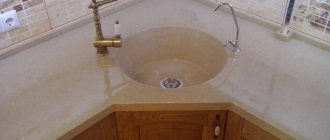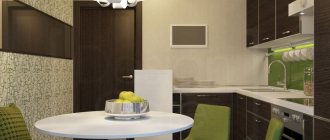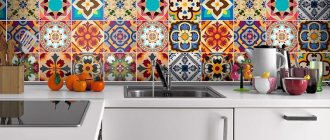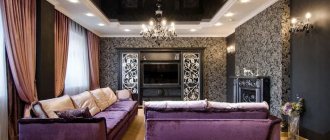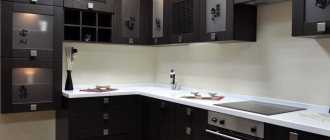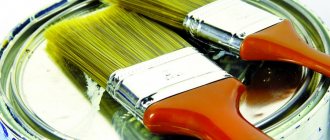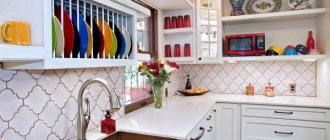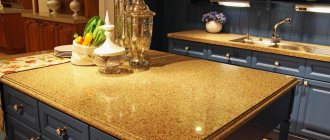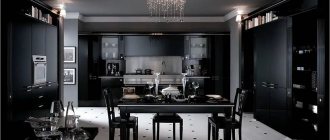When deciding which facades to choose for the kitchen, you need to understand the materials used for manufacturing, the types of facades, the basics: laminated chipboard or MDF and know what options there are for decoration. Choose in what style: classic, hi-tech, etc. the kitchen is planned. Study the pros and cons of a particular type of kitchen unit. We choose what color the furniture is needed so that it matches the interior design of the kitchen. You should also carefully choose the countertops and kitchen fronts for cabinets.
Types of kitchen facades
There are different types of kitchen facades. Their service life will largely depend on what material they are made of. The main types of kitchen facades can be distinguished depending on their structures, design, materials, types of coatings, etc. Furniture facades are as follows:
- 3D facades;
- curved facades for the kitchen;
- classic facades;
- kitchen facades with glass;
- perforated facade;
- plastic facades;
- radius facades;
- frame facades;
- with inserts into chipboard glass facades;
- supermatte facades “Soft-touch”;
- lattice façade;
- facades made of MDF;
- PVC facades;
- facades with patina;
- facades-blinds;
- veneered kitchen facades;
- environmentally friendly Cleaf facades, TSS Cleaf slabs made of natural materials and others.
Basics
To understand which facade to choose for the kitchen, it is worth understanding what is included in their basis. The production of such a core occurs, as a rule, from chipboard, which can also be laminated, or MDF boards:
- Chipboard:
Cheap option. Despite good resistance to moisture and temperature changes, it wears out in 5-8 years.
- MDF:
It will cost more than the previous one, but its service life will be longer. It is a dense, durable and quite flexible material. It is easy to process, which allows you to make the desired size and shape.
What materials are used for decoration
The finished furniture kitchen set gains additional attractiveness due to the different decor. You can give the facade a wood look, for example, bleached oak or cedar, since it is really very expensive to make facades from solid oak. A special PVC film is often used for MDF facades - film coating. Enamel, varnish, paint, acrylic plastic, and patination are also used for the kitchen.
laminated chipboard
Chipboard, although the most affordable, is not very wear-resistant, so lamination is often used in their case. Finished facades from laminated chipboard are assembled from separate panels, the thickness of which is 2-4 cm. Laminated chipboard is quite easy to process, which allows you to create various shapes, but radius facades are never made from it. With laminated chipboard facades, you need to remember that they are not resistant to prolonged exposure to elevated temperatures.
PVC film
The use of PVC film for furniture facades is quite common. This is a thermoplastic coating. As a rule, it is MDF kitchen facades that come in PVC film. This coating is made under the influence of high temperatures. A protective layer of about 0.2-0.5 mm is created using special equipment. PVC film for kitchen facades provides:
- immunity to moisture, elevated temperatures and UV rays;
- resistance to wear and mechanical damage.
Such a film as a cladding is inexpensive.
Plastic
Plastic kitchen facades are considered the most practical. A special adhesive is used for PVC film for MDF or chipboard facades, with which a thin layer of plastic is fixed. Kitchen facades made of plastic do not fade over time, do not wear off or get scratched. They are resistant to chemical attack. In addition, plastic facades are easy to maintain. In some models of kitchen facades, plastic has an additional compensation layer, which prevents deformation.
Enamel (paint)
Enameled slabs are those that are coated with an enamel layer, paint or varnish. Facades with enamel can be of various colors, not only white, and have certain effects: silver, gold, metallic shine, chameleon. The enamel coating provides resistance to moisture and elevated temperatures, and also prevents deformation. It is easy to care for; any product will do, as long as it is non-abrasive.
However, such a coating may become chipped when impacted.
Veneer
One option is veneered facades. Veneer facades imply natural wooden layers no thicker than 0.5 cm. Veneer facades are particularly durable. They withstand exposure even to very high temperatures. Visually, veneered facades are no different from expensive solid wood models. It is possible to restore the damaged area locally without completely replacing the facing part.
However, veneer is not the cheapest material. Plastic facades, for example, will be cheaper.
Types of ends of various coating options
The ends of the slabs are covered with edging - a special edge that gives completeness to the appearance, as well as additional protection. It is made from the following materials:
- Acrylic:
Long lasting and durable. The edge is almost invisible. Acrylic is well suited for minimalist, loft or high-tech facades.
- Aluminum:
An aluminum frame profile for plastic facades is an excellent option. It is durable and has good rigidity. Keeps its shape and does not crack.
- PVC:
The most common and affordable option. Not very durable and subject to wear and tear, may crack over time.
Rules of care
The fundamental principle in cleaning facades is the use of non-abrasive detergents. Before you start cleaning, pay attention to the following nuances:
- products made from solid wood do not like household chemicals: here it is better to limit yourself to warm water and a soft cloth;
- MDF and laminated chipboard panels are cleaned using gels and liquid products that form a slight foam;
- to add shine to glossy and matte surfaces, use furniture polish;
- glass facades are cleaned using special profile products;
- do not use formulations containing bleach or solvents;
- The surfaces must be wiped at least once a week, and also when they become dirty.
The best way to keep facades clean is to regularly care for them. Don’t forget to wipe the panels in the evening with a cloth slightly moistened with water.
The durability of a furniture set will depend on proper use of the items. When choosing, give preference to high-quality, well-proven manufacturers and then the result will please you with its practicality.
What are MDF facades in PVC film?
Facades are made, as a rule, from wood materials: wood, MDF and chipboard. The latter can be laminated using postforming technology in the factory. In addition, there are radius facades or curved facades. For them, several layers of glued chipboard, special MDF or plywood are used. Unlike chipboard, which are straight slabs, milling on facades, of which it is impossible, MDF has great capabilities. They are also able to imitate various textures. It is possible to mill facades from MDF. In addition, they can be enameled, painted and sanded. But the most economical option would be to cover them with polyvinyl chloride (PVC) film.
In production this happens in several stages:
- a straight or other shaped part is cut out;
- if necessary, milling is performed on the facades;
- the surface is carefully polished;
- Crimping is carried out with PVC film.
Possibility of milling
The facade can be made with milling, when the corners are chamfered. Milling on facades is performed with a milling cutter with a 2-3 mm radius. The milled facade does not have sharp edges, which means it becomes safer. Milling is carried out taking into account the selected textures and colors of the planned PVC film:
- using a figured cutter to imitate wood;
- a small radius of the cutting tool is taken if you are planning a classic white frame facade for the kitchen;
- if you need metallic MDF frame facades, then choose a larger chamfer radius;
- For applying patterns to the surface and other similar processing, milling and engraving machines with program control are used.
If the slab is covered with enamel or polish, then there is no need for milling.
Large selection of decor
Decoration options can be very different:
- mirror surfaces that visually increase the space;
- imitation, making facades visually wooden or glass;
- “chameleon” type films that change color depending on the lighting;
- various effects: shine, gloss, silver, gold, turquoise, champagne, etc.
The shape can be radius facades, curved facades, smooth facades with 3D images, etc.
Standard and custom sizes
There is another very important feature that must be taken into account, these are the dimensions of the kitchen facades. They are standard and non-standard. Let's take a closer look at each. Standard doors, from the word “standard”. There is a certain grid of door sizes that is taken into account when drawing up the project.
Non-standard doors are an option that allows you to order a façade of any size. Let's say you have decided on a style, chosen a material that suits you, and before you start designing a project, study the size range and find out if it is possible to use non-standard sizes.
It is easier to use a standard mesh when drawing up a project, but if necessary, resort to making a non-standard one. The only small nuance is that non-standard ones are more expensive in price.
Types of plastic for kitchen facades
Plastic kitchens look beautiful. But the choice of material should be approached carefully so that the furniture lasts as long as possible. There are different types of plastic for kitchen sets:
- CPL plastic;
- HPL plastic;
- ecoplastic 3D;
- acrylic plastic.
CPL plastic
CPL is a roll of plastic that is attached under medium pressure to the slab. Such facades have a very attractive appearance and low price, but this material is not resistant to mechanical stress and sunlight. Its structure is comparable to dermantine and its use is not possible everywhere.
HPL plastic
HPL is a durable and very reliable plastic. It is already attached under high pressure. Arpa plastic is often applied to facades. This Italian company has been specializing in decorative HPL plastic for more than fifty years. Such furniture is resistant to moisture, durable and with good rigidity.
3D ecoplastic
The thickness of this coating is 0.2 cm, which provides additional protection and strength. This plastic is great for simulating wood, stone, etc., and the Soft-Touch coating allows you to create a variety of shades.
Acrylic plastic for kitchen facades
Durable and wear-resistant material. Durable, moisture and steam resistant, does not fade and shines beautifully. However, its use is only possible on straight, solid facades, and it will also have to be periodically wiped to remove fingerprints and other things. The price of such material is quite high.
IKEA is your assistant
Do you want to have unique and budget-friendly kitchen furniture? We give advice: first, purchase ready-made cabinets of the required sizes; IKEA has a choice, and buy the front part separately.
Another option is to order the filling of the cabinets from a local manufacturer, and for the front part of the project, buy IKEA kitchen facades.
Veneered facades
For veneer facades, different types of wood are used, sometimes even exotic ones. Kitchen veneer can be:
- multi-veneer;
- natural;
- fine line;
- color.
Due to its flexibility and plasticity, facades can have various configurations. The paneled frame facade has a stylish appearance, where the panel is made of veneer and the frame is made of wood.
The advantages of this type include:
- long service life;
- affordable price;
- wear resistance;
- easy care;
- ease of repair;
- modern design;
- environmental friendliness.
Among the disadvantages, it is worth noting that veneer, like other wood materials, is not resistant to UV radiation, so it may fade over time, but in this case it is always possible to renew the coating. The price of such furniture is higher than plastic.
Recommendations for selection
So which kitchen facades are better? A very frequently asked question. In previous chapters, we described facade options, pros and cons of materials. The choice is yours. In the beginning, ask yourself whether you want a solid kitchen for the long term or whether you like to change the interior every five years.
If you want a long-term project, then choose a model made of wood, plastic, veneer or ceramics. If you quickly get bored with everything and like to change things often, then choose all the other options.
Solid wood facades
Solid wood kitchens are made from both soft and hard wood:
- Soft:
Practical and easy to manufacture. The most popular are spruce and pine. Prices are a little higher than average.
- Solid:
Reliable and durable. Such trees are planted individually, and their number is limited. Prices are high.
The advantages of wooden furniture are as follows:
- durability;
- individuality;
- environmental friendliness.
The disadvantages include the same as veneer: instability to ultraviolet radiation and high prices.
Variety of choices
The modern furniture industry offers a wide range of materials for the manufacture of facades. The interior of the set is mainly made of chipboard, MDF or solid wood.
But the facades are distinguished by a large selection: wood, chipboard, plastic, film-coated MDF, enamel-coated MDF, veneer, metal, glass (painted or photo-printed glass). It’s up to you to decide what the face of your kitchen will be.
Coating of facades with enamel (painted facades)
Enameling is quite popular due to the variety of colors and shades. In addition, you can create absolutely any tone to order. And if necessary, you can repaint the finished set.
Enameled facades are environmentally friendly; even during their production there are no harmful emissions into the atmosphere. They do not fade or fade.
This coating has virtually no flaws, except perhaps fingerprints on the glossy surface. But this can easily be eliminated by simply wiping.
Small scratches on such furniture are practically invisible, and besides, it can be updated at any time by painting it in the desired color.
Acrylic
+ super moisture resistant, huge selection of colors, does not fade, temperature stable, perfectly smooth surface.
- susceptible to impacts, fingerprints, scratches.
How not to lose money when ordering a kitchen set: 10 tricks of unscrupulous sellers
How to choose the right kitchen and not make the mistake of getting what you expected for your money? Be careful of the following:
- Replacing fittings with cheap analogues - for example, installing door hinges or drawer guides from an unknown Chinese manufacturer instead of branded parts. Or the plastic covers with the logo on the pull-out boxes are being replaced - logos are sold separately. Another option is to install no-name supports and hangers, cheap eccentrics. Dowels are not installed when assembling cabinets.
- Saving on material - for example, the depth of the drawers is less than stated in the order, or reducing the number of shelves. Another thing is a thicker base on the table top and a thin layer of acrylic coating.
- Replacement of material - instead of MDF, they install a body made of laminated chipboard with a low-quality plastic coating and poorly glued edges with a similar coating. HDF is installed on the back, not fiberboard.
- Furniture showrooms sell built-in household appliances at a huge markup and resell countertops made of artificial stone.
- Dust in the eyes - a lot of certificates and other diplomas. Look at the experience in the market and what the company has in its portfolio.
- Talk about the size chart when ordering a kitchen and extra money for non-standard ones. Standard kitchens are sold in stores, but you initially came to order according to your sizes.
- Hidden fees – additional services in small print in the contract.
- Unreal discounts on kitchens - the maximum that a manufacturer can give is 10% of the price. And only if the dollar exchange rate fluctuates in his favor.
- It is not tempered glass that is placed on the apron, but simple glass with a film so that it does not immediately crack.
- Interest-free installments - the story is the same here as in banks. All interest is already included in the cost of the headset.
We wish you good luck in choosing and purchasing a kitchen set!
Color solutions
Which façade is best to choose depends on the style. The shape, color, and even the choice of objects are dictated by the general concept. In this case, the proportions and area of the room itself are taken into account, since a poor choice of color can greatly spoil the impression, while a successful choice can make the room cozy and interesting.
- Classic involves only imitation wood. The color is determined by personal tastes and the size of the room: for a small kitchen it is undesirable to purchase a set that reproduces the color of stained oak or ebony.
- Baroque and Empire definitely prefer light wood; bright warm colors are excluded because they look too cheap. Red shades are allowed, but very light wood or painting white and salmon is preferable: these shades go better with “golden” fittings and molding.
The photo shows a neo-Baroque style kitchen.
Neo-Baroque is even more original - here the classic facade with carved decorations is covered with “metallic” paint - steel, bronze. A very effective solution.
- The rustic style uses primarily white, or rather, wood painted white. The ideal solution is an aging effect, which requires a combination of several shades. Perhaps this is only when painting wood or MDF with enamel, so in fact, kitchens in the English style or Provence are not a cheap pleasure.
- For a kitchen in the Art Nouveau style , options finished with acrylic film, panels and painted with enamel are suitable: single-color or gradient smooth facades with a glossy sheen - literally the “standard” Art Nouveau solution. Within one set, you can combine 3 colors plus white, use a pattern on individual doors, and even decorate the facades with photo printing, as in the following video.
- Techno , oddly enough, will prefer imitation wood - dull and dark in combination with plastic facades of “metallic” tones - gray, black, dull golden, silver.
- In a high-tech kitchen, active use of radius facades and bright color effects is assumed. It is allowed to mix no more than 2 colors plus a neutral one - black or white, but in combination with a glossy sheen.
- Art Deco involves a combination of smooth facades made of “expensive wood” with patterned plastic panels.
- Loft and industrial - smooth facades imitating dark wood with an inexpressive pattern. Ideally, wood should be combined with a steel tabletop or dull gray doors.
- A fusion style kitchen is the most incredible interior. Here you can easily combine headset elements from different styles, as long as they all form a single geometric composition.
Which kitchen façade to choose depends on the stylistic concept, material capabilities, size and configuration of the room, and so on. And only by assessing all the factors and distributing them in order of importance can you find the best solution.
